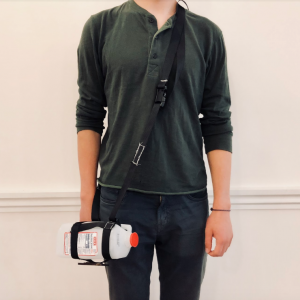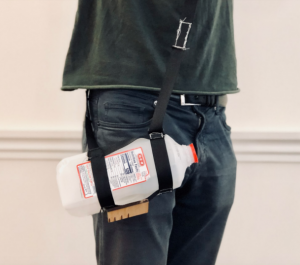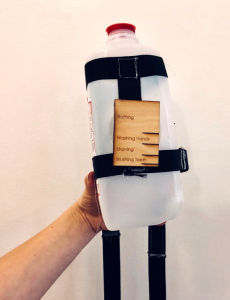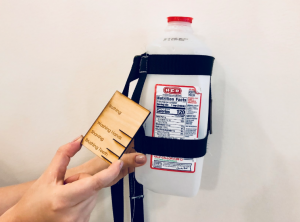Build:
Our HCW statement was “How can we ensure homeless individuals in Houston’s tent camps have an easy way to carry their water to maintain good hygiene?” We started off with 5 spaces where we could potentially build a prototype in: delivery services, refilling stations, waterless hygiene, information distribution and carrying methods. After doing “axis” exercises, it was clear that the most feasible and realistic space would be carrying methods.
Our prototype is a sturdy, yet extensible strap that will attach the half gallon milk cartons in two places to make the carrying of these full cartons easier. A half gallon of water weighs a little over 4 pounds, which can be burden to carry in your hand. Thus, our strap makes it easy to carry this amount of water over your shoulder or makes it easy to attach to your backpack.
Our prototype also includes a measuring stick that helps users become more aware of their water usage by measuring out the approximate amounts of water it should take to do things such as brush teeth and shave.
Conclusions
Throughout the project, we continued to learn about the population we are trying to serve. We conducted enough research to recharacterize the problem away from the loss of homeless documentation to improving water accessibility. Through conversations with Kenneth, the outreach coordinator for Star of Hope, we learned about current issues that face the homeless such as their current forced relocation away from the tent camps in downtown Houston. We also learned about the engineering design steps of identify, immerse, reframe, ideate, build, and test. Using the process made every decision taken to be objective and backed by some data.
We also learned many lessons that would help for the future for continuing this project or working with the homeless in general. The homeless population tend to be hard to talk to, which is especially important in the immerse part of the Engineering Design Process. When we went on our ride alongs and distributed care packages, we planned to talk to the homeless while we gave the packages. We did not realize that most would take the “hope bags” and leave. And the few times we asked our questions to the homeless to elaborate on the sources of water, we received incomplete or repetitive answers about the scarcity of water and the need for more water sources.
A recommendation for the future is to be less inhibited by the newness of the situation and be more open to initiating and continuing the conversation. We are talking with strangers who might be less willing to talk about the struggles they face everyday and are unaware of how to give the best information possible to help those in the engineering design process. However, more conversation would lead to more key insights which would make it easier to build a prototype for the group’s specific needs.
Everyone on the team had lots of fun on the project and are thankful for the structure of Design for America that made this fun and learning possible!!



